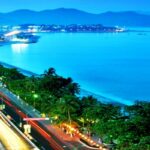- Posted on
- By indrek
- In Ho Chi Minh (SAIGON)

Cu Chi Tunnels: A Fascinating Look into Vietnam's War History
The Cu Chi Tunnels, located just outside of Ho Chi Minh City (formerly known as Saigon), are a fascinating testament to the resilience and ingenuity of the Vietnamese people during the Vietnam War. These underground tunnels were used by the Viet Cong, the communist forces fighting against the South Vietnamese and American armies, as a base for their operations. Today, the Cu Chi Tunnels are a popular tourist attraction, offering visitors a glimpse into the past and an appreciation for the sacrifices made during the war. Củ Chi tunnels – Wikipedia
History of the Cu Chi Tunnels
The Cu Chi Tunnels were originally built by the Viet Minh during the French colonial period in Vietnam, which lasted from the 19th century until the mid-1950s. After the French were defeated, the tunnels were expanded by the Viet Cong, who used them extensively during the Vietnam War.
The tunnels were used for a variety of purposes, including as living quarters, storage areas, hospitals, and command centers. They were also used to launch surprise attacks on the enemy, as well as to transport troops and supplies. The tunnels were an essential part of the Viet Cong’s strategy, allowing them to operate covertly and avoid detection by the American and South Vietnamese armies.
The Cu Chi Tunnels were a symbol of the resilience and determination of the Vietnamese people during the war. Despite the overwhelming military might of the Americans, the Viet Cong were able to hold their ground and eventually drive the Americans out of Vietnam. The tunnels played a significant role in this victory, and their importance is still celebrated by the Vietnamese people today.
Visiting the Cu Chi Tunnels
Today, the Cu Chi Tunnels are open to visitors, who can explore a small section of the tunnels and learn about their history. There are several ways to visit the tunnels, including organized tours from Ho Chi Minh City, as well as private tours and self-guided visits.
One of the highlights of visiting the Cu Chi Tunnels is the chance to crawl through a section of the tunnels yourself. The tunnels are narrow and claustrophobic, but they offer a unique perspective on the war and a deeper appreciation for the sacrifices made by the Vietnamese people.
There are also several exhibits and displays at the site, including weapons used by the Viet Cong, booby traps, and a recreation of life in the tunnels. Visitors can also watch a short film about the tunnels and their history, providing a fascinating look into the past.
The Cu Chi Tunnels are an essential stop for anyone interested in the history of the Vietnam War. They offer a unique perspective on the conflict and provide insight into the tactics and strategies used by the Viet Cong. Moreover, the tunnels are a testament to the resilience and ingenuity of the Vietnamese people, and visiting them is an opportunity to pay tribute to those who sacrificed so much during the war.
Conclusion
In conclusion, the Cu Chi Tunnels are a remarkable historical landmark that showcase the bravery and ingenuity of the Vietnamese people during a difficult period in their history. A visit to the site is a powerful reminder of the sacrifices made during the war and a testament to the resilience of the human spirit. It is an experience that will stay with you long after you have left Vietnam.
For those interested in history, the Cu Chi Tunnels are an absolute must-visit destination in Vietnam. But even if you’re not a history buff, the site offers a unique experience that is sure to leave a lasting impression. The tunnels are an incredible feat of engineering and a testament to the determination of the Vietnamese people. Walking through them and seeing the cramped conditions under which the soldiers lived and fought is a humbling experience that will leave you with a greater appreciation for the sacrifices made during the war.
Moreover, the site is a popular destination for both domestic and international visitors, so it is important to book your visit in advance. With a reputable tour operator, you can get an expert guide who will provide you with insights into the history and significance of the tunnels. Plus, you can rest assured that your visit will be safe and hassle-free.
In summary, the Cu Chi Tunnels are a unique and fascinating destination that offers visitors a glimpse into Vietnam’s war history and the sacrifices made during the conflict. It is a powerful reminder of the resilience of the Vietnamese people and the human spirit, and a visit to the site is an unforgettable experience that you won’t want to miss.
Read more: Ho Chi Minh City | Navigating HCMC Airport Transfers

Recent Posts
- Discovering Ho Tram July 20, 2024
- Hang Son Doong is The World’s Largest Cave April 28, 2024
- Saigon nightlife April 23, 2024
- How to Choose the Best private transfer service April 22, 2024
- Ultimate Guide to Mui Ne Tours April 14, 2024




